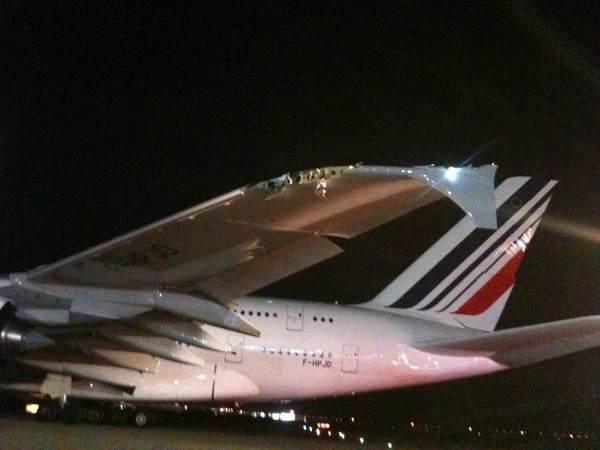Society
NY airport collision shows risks of huge planes
Updated: 2011-04-13 13:50
(Agencies)
NEW YORK - A frightening collision between one of the world's largest airliners and a commuter jet on a dark, wet tarmac at John F. Kennedy International Airport is underscoring worries about ground accidents as US airports begin handling a new generation of giant planes.
A total of 586 passengers and crew members were aboard the two aircraft Monday night when the left wing of an Airbus A380 operated by Air France clipped a Bombardier CRJ-700 regional jet flown by Comair, spinning the smaller plane nearly 90 degrees. No one was injured.
|
||||
"It's the sheer size of these aircraft and the congestion at these airports that's the problem," said Allan Tamm, a consultant with Avicor Aviation, based in Portland, Oregon. "It's a serious concern for all these airports trying to accommodate these aircraft. It's going to happen more and more."
The collision happened at one of the most congested US airports on a rainy night when flashing lights reflecting off wet tarmac can obscure small aircraft. It comes as airports around the country are beginning to receive a new class of huge aircraft.
Fourteen airports have obtained waivers from the Federal Aviation Administration to receive the new Boeing 747-8, which falls into the same new size class as the A380, The Associated Press reported this week. And Boeing is working with 13 more airports to get approval from the FAA, though not all of them may require waivers.
Most US airports cannot legally handle the A380 or 747-8 lying in the US increased from 767 million in 2009 to 782 million in 2010.
JFK was built in the 1950s, when jets were smaller. Airport officials had to secure FAA waivers for the A380 and the 747-8. Monday's collision might spur the FAA to take a second look at JFK's rules for handling large aircraft, said aviation consultant John Cox.
The National Transportation Safety Board is reviewing radio recordings, radar data and flight recorders from both aircraft in Monday's accident.
The impact tore open the leading edge of the Airbus' left wing and broke off half of the wing fence, a vertical fin that sticks out from the wingtip, photos from the NTSB show. The Bombardier had a hole in its rudder and a dent on the leading edge of the tail.
"This wasn't just two airplanes bumping together. The Air France plane really creamed the regional jet," said Bill Voss, president of the Flight Safety Foundation, an advocacy grouposs said.
The collision shook the Comair jet "very, very violently," passenger Sabastian Pinel said, "and then the next thing we knew we were told to hurry out the plane."
Air France passenger Stephen Brown said he saw "a little puff of smoke."
"I says, 'Oh, there's a bit of smoke,' and then we seemed to stop as if the pilot was putting the brakes on a bit too quickly," Brown said.
The main danger in a collision between two taxiing aircraft is that a fuel spill will lead to a fire, Cox said. He praised the flight crew of the regional jet for immediately requesting airport fire and rescue help.
Kennedy's FAA-approved rule book for the A380 is 36 pages long and limits the planes mostly to Taxiway A, which encircles the terminals. The Air France flight was on Taxiway A. Other planes may have to be held on taxiways until the A380 passes by, Cox said.
The problem of planes colliding with each other on runways - or with baggage carts, other vehicles or people that might be crossing runways - has been a top aviation safety concern since the late 1980s, when there was a spate of deadly incidents.
Among the steps taken by FAA have been briefings on runway safety for air traffic controllers, improved airport signs and other markings so that pilots know where to turn, and installation of runway lights that turn red to warn pilots against entering or landing on the runway or taxiway. However, only about two dozen airports have the runway lights.
Beginning in 2001, the FAA began installing warning systems that collect and analyze data from airport radar in order to detect pt of air travel often overlooked by passengers eager to get out of their seats and on their way home, experts said.
Specials

Share your China stories!
Foreign readers are invited to share your China stories.

Art auctions
China accounted for 33% of global fine art sales.

Waiting for drivers' seat
Lack of sponsorship appears to be why Chinese drivers have yet to race in a Formula 1 event




